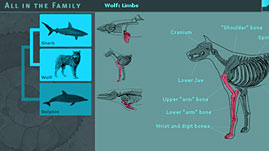Knowing your family tree can help explain why you look, and even act, the way you do. Your parents passed down to you a combination of your ancestors' genes. Since genes play a critical role in determining appearance, relatives tend to have features in common, and siblings are the most similar-looking, since they share the most genes. Imagine you don't know the structure of your family tree, but you have pictures of everyone in it for ten generations back. Could you build an accurate tree based on those pictures? Would appearances alone be enough to determine familial relationships? Evolutionary biologists, called cladists, are constructing one enormous phylogenetic (family) tree, branch by branch, that will include every organism that has ever lived on earth. They use a variety of tools to do this, but they begin, as you will in this activity, by comparing key features of appearance.


 Loading Standards
Loading Standards Teachers' Domain is proud to be a Pathways portal to the National Science Digital Library.
Teachers' Domain is proud to be a Pathways portal to the National Science Digital Library.
